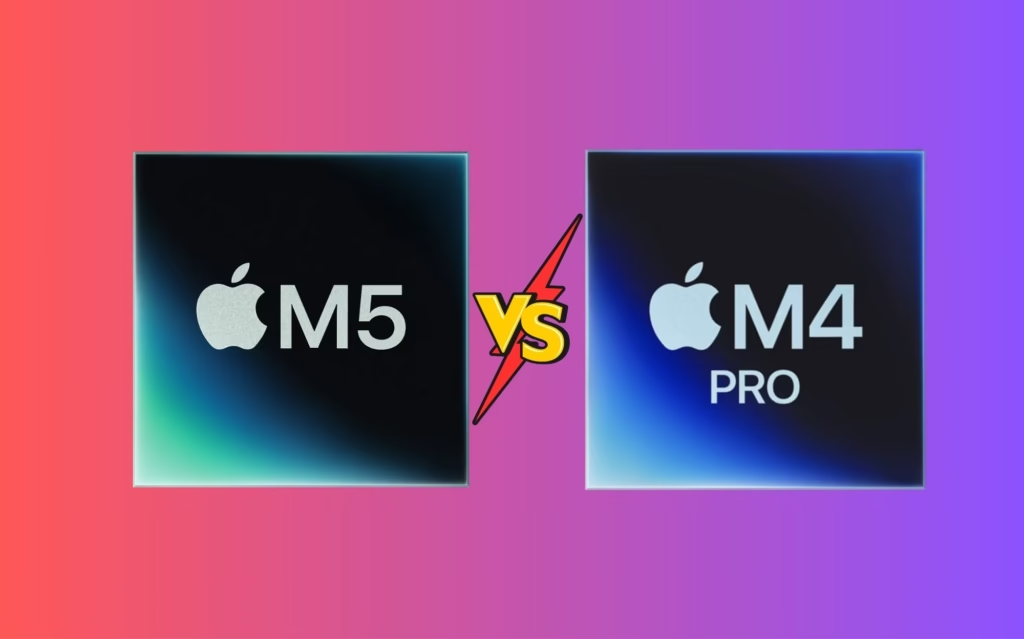Apple has officially launched its latest M5 chip in October 2025, and as expected, it has started a fresh round of debates: Is it really that much better than the M4 Pro? Should you upgrade?
The M4 Pro was already a beast, powering high-end iPads and Macs with strong CPU cores, blazing-fast GPUs, and serious memory bandwidth. But the M5 claims to take things further – especially in AI, graphics, and efficiency.
Let’s make things simple and compare the two, step by step.
Quick Spec Sheet: M5 vs M4 Pro
| Feature | Apple M4 Pro | Apple M5 |
|---|---|---|
| Process Node | 2nd-gen 3nm | 3rd-gen 3nm (more efficient, cooler) |
| CPU Cores | Up to 12 (8 performance + 4 efficiency, depending on config) | 10 cores (4 performance + 6 efficiency) |
| CPU Performance | Already very strong | ~15% faster multithreaded over base M4 |
| GPU | High-core GPU, hardware ray tracing | New GPU with Neural Accelerator in every core |
| Graphics Performance | Great for 3D, video editing, gaming | Up to 45% faster graphics + big ray tracing gains |
| AI/ML Performance | Neural Engine for ML tasks | 4× AI compute boost with new GPU + Neural Engine |
| Memory Bandwidth | Up to 200 GB/s on top configs (120 GB/s on base) | 153 GB/s standard |
| Special Features | Strong GPU options, high bandwidth configs | Wi-Fi 7, Bluetooth 6 (N1 chip), faster modem, better thermal efficiency |
| Devices | iPads, Macs (2024 models) | New iPad Pro, upcoming Macs (2025 onwards) |
Technical Comparison: M5 vs. M4 Pro
Process Node
The M4 was made on Apple’s second-gen 3nm process, which was already pretty advanced. With the M5, Apple has moved to a third-gen 3nm design. On paper it sounds like a small step, but it brings real gains — better power efficiency, cooler operation, and the ability to hold peak performance for longer without heating up.
CPU: Cores and Performance
Both chips come with 10 cores, but Apple has changed the balance a little. The M5 uses 4 performance cores and 6 efficiency cores, designed to deliver more speed without wasting energy. Thanks to these changes and the improved chip design, the M5 is about 15% faster in multithreaded tasks compared to the base M4.
That said, the M4 Pro is still no slouch. With more performance cores, it remains extremely powerful. The difference is that the M5 focuses on smarter efficiency and smoother sustained performance, making it better suited for modern, heavy workflows.
GPU and Graphics
The M4 family, especially the M4 Pro, was lauded for its powerful GPU with hardware-accelerated ray tracing. The M5 introduces a revolutionary change by integrating a “Neural Accelerator in each GPU core.” This fundamentally enhances its architecture for modern workloads.
Apple’s performance claims are staggering:
- The M5 can deliver over 4× the peak GPU compute performance for AI tasks compared to the M4.
- For traditional graphics workloads like 3D rendering and gaming, the M5 offers up to a 45% performance uplift over the M4, with significant improvements in ray tracing.
Neural Engine and AI Acceleration
While the M4 has a capable Neural Engine for machine learning tasks, the M5 massively upgrades AI acceleration. By combining an enhanced Neural Engine with the new Neural Accelerators inside the GPU cores, the M5 provides a much stronger and more distributed system for handling complex AI and ML models.
Memory and Bandwidth
The M5 chip supports a unified memory bandwidth of 153 GB/s, a roughly 30% increase over the 120 GB/s offered by the base M4. This boost provides better throughput and more headroom for memory-intensive tasks like video editing, 3D modeling, and running large datasets. While higher-tier M4 Pro configurations offered increased bandwidth, the M5’s new baseline sets a higher standard for the entire platform.
Practical Implications and Use Cases
Where the M5 Excels
-
AI and Machine Learning: With a 4x jump in AI performance, the M5 is built for the future. Tasks like neural networks and other AI-heavy apps run faster and more efficiently than ever.
-
Graphics Power: For 3D creators, game developers, or video editors, the 45% boost in graphics makes a real difference — faster renders, smoother playback, and a more responsive workflow.
-
Effortless Multitasking: Thanks to higher memory bandwidth, running multiple heavy apps at once feels smooth. Designers, editors, and professionals who juggle demanding software will notice the difference right away.
-
Future-Ready: The M5’s new design is made to handle the next wave of software, which means devices powered by it will stay relevant and powerful for years.
Where the M4 and M4 Pro Still Hold Up
-
High-End Builds: A fully specced M4 Pro is still extremely powerful and more than capable of handling tough professional workloads.
-
Everyday Tasks: For browsing, documents, and streaming, the gap between M4 Pro and M5 is barely noticeable.
-
Value for Money: If the M4 already meets your needs, upgrading may not make sense. It’s still a strong, reliable option without the added cost.
Verdict: Should You Upgrade?
Whether or not you should upgrade really depends on the device you already have and how demanding your work is. If you’re using a top-end M4 Pro, the new M5 won’t feel like a game-changer for daily tasks, though people working heavily with AI or graphics will see the benefits. For anyone on the base M4 or an older chip, the M5 is a big step up — faster, more efficient, and instantly noticeable in performance.
If your needs are simple and you don’t want to spend extra, the M4 is still more than capable for browsing, office work, or entertainment. But if you’re someone who always wants the best hardware available, the M5 is the clear choice, offering more power now and the kind of future-proofing that will keep it relevant for years.
Note:It’s important to remember that a top-tier M4 Pro (with a high GPU core count and maximum memory) might still be comparable to or even exceed the base M5 in certain specific graphical or memory-bound scenarios. However, the M5’s architectural advantages, especially in AI, give it a significant lead in next-generation applications.


